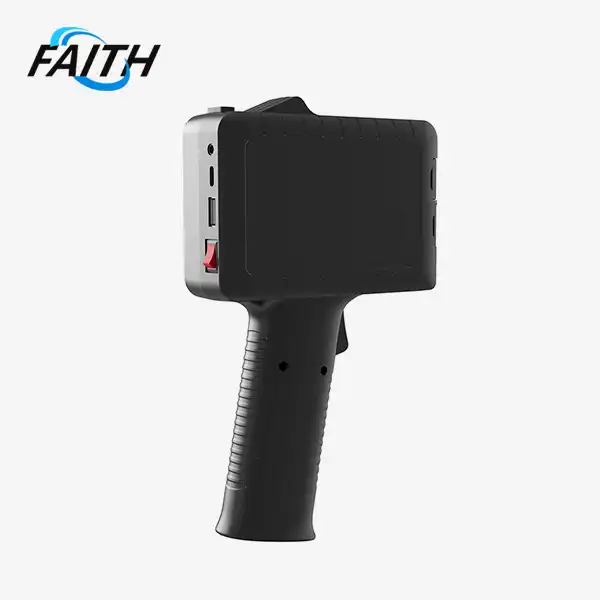What is the use of handheld printer?
A handheld printer is a versatile, portable device designed for on-the-spot printing on various surfaces. These compact machines offer unparalleled flexibility in printing locations, making them indispensable for tasks such as labeling, marking, and coding across diverse industries. Handheld printers, especially handheld date printers, excel in applications requiring real-time date stamping, batch coding, and serialization. Their ability to print on materials like plastic, metal, glass, cardboard, and wood makes them invaluable in manufacturing, logistics, retail, and quality control processes. By providing instant, customizable printing solutions, handheld printers streamline operations, enhance traceability, and boost productivity in dynamic work environments.
The Revolutionary Impact of Handheld Date Printers in Modern Industries
Handheld date printers have emerged as game-changers in various sectors, offering unprecedented flexibility and efficiency in printing operations. These compact devices have revolutionized how businesses handle date coding, batch numbering, and product identification. Unlike traditional stationary printers, handheld models allow for immediate, on-site printing, significantly reducing downtime and increasing productivity.
One of the most striking features of modern handheld date printers is their versatility. Take, for instance, the latest models that boast a 4.3-inch touch screen interface. This user-friendly design ensures smooth operation and quick response, making it suitable for a wide range of industrial applications. The ability to insert and print date, time, and serial numbers with ease has made these devices indispensable in production lines and warehouses.
Moreover, the adaptability of handheld date printers extends to their printing capabilities. Many models support multiple date formats and time formats, catering to diverse regional and industry-specific requirements. This flexibility is further enhanced by their support for technical number displays and customizable serial number formats, making them ideal for complex coding needs in manufacturing and logistics.
Multilingual Support: Breaking Language Barriers
In our increasingly globalized world, the multilingual support offered by advanced handheld date printers is a significant advantage. With support for over 30 languages, including Japanese, Korean, French, Italian, Portuguese, Spanish, and Russian, these printers facilitate seamless operations in multinational companies and export-oriented businesses. This feature ensures that product information remains consistent and comprehensible across different markets, enhancing global trade and compliance with international regulations.
Adjustable Printing Direction: Meeting Diverse Production Needs
The ability to adjust printing direction is another crucial feature that sets modern handheld date printers apart. With 360-degree adjustable printing, these devices can accommodate various production line setups and packaging designs. This flexibility is particularly valuable in industries where products come in different shapes and sizes, or where printing surfaces are not always easily accessible.
Technical Prowess: The Backbone of Handheld Date Printer Functionality
The effectiveness of faith printer like handheld date printers lies in their impressive technical specifications. These devices are not just about portability; they pack a punch when it comes to printing performance. Understanding these technical aspects helps in appreciating the true value and capabilities of these innovative printing solutions.
One of the most notable features is the printing length capacity. Many advanced models can handle up to 2000 characters per message, with virtually unlimited length potential. This extensive capacity allows for detailed product information, comprehensive traceability codes, and even small-scale graphics to be printed directly onto products or packaging.
The adjustable printing distance, typically ranging from 1-10mm, adds another layer of versatility. This feature enables operators to achieve optimal print quality on various surface textures and contours, ensuring legibility even on challenging materials.
High-Resolution Printing: Clarity in Every Detail
Print quality is paramount in industrial applications, and handheld date printers deliver admirably in this aspect. With adjustable printing accuracies of 300, 400, or 600 DPI (dots per inch), these devices can produce crisp, clear prints that meet stringent quality control standards. The ability to adjust the resolution allows users to balance between print quality and ink conservation, depending on the specific requirements of each application.
Furthermore, the printing speed of up to 70m/min demonstrates the efficiency of these devices. This rapid printing capability ensures that production lines can maintain high throughput rates without compromising on the quality or accuracy of date coding and other printed information.
Versatile Print Height and Ink Technology
The flexibility in print height, ranging from 2mm to 12.7mm, allows handheld date printers to adapt to various labeling and coding needs. Whether it's small serial numbers on electronic components or large batch codes on shipping cartons, these printers can handle diverse requirements with ease.
Equally important is the ink technology employed in these devices. The use of fast-drying, waterproof, and UV-resistant inks ensures that the printed information remains legible and durable, even in challenging environmental conditions. This durability is crucial for traceability and quality control, particularly in industries where products may be exposed to harsh conditions during storage or transportation.
Connectivity and Usability: Enhancing Operational Efficiency
In the era of Industry 4.0, connectivity plays a crucial role in the effectiveness of industrial equipment. Handheld date printers are no exception to this trend. The integration of various connectivity options has significantly enhanced their usability and operational efficiency.
Modern handheld date printers typically offer multiple connectivity options, including USB, WiFi, and Bluetooth. This versatility in connectivity allows for seamless integration with existing production systems and data management platforms. For instance, WiFi connectivity enables real-time updates to printing templates, ensuring that date codes and other printed information are always current and accurate.
The USB connectivity option provides a straightforward method for transferring print templates and updating firmware, making maintenance and upgrades a breeze. Meanwhile, Bluetooth connectivity offers the advantage of wireless printing from mobile devices, which can be particularly useful in dynamic warehouse environments or for field operations.
Extended Battery Life: Powering Through Long Shifts
One of the key factors that determine the practicality of a handheld device is its battery life. In this regard, advanced handheld date printers excel, with many models offering up to 10 hours of continuous use on a single charge. This extended battery life ensures that the printer can operate throughout long production shifts without interruption, maximizing productivity and minimizing downtime.
The long battery life also makes these printers ideal for use in large warehouses or outdoor environments where access to power outlets might be limited. It provides the flexibility to move the printer wherever it's needed without constantly worrying about recharging.
User-Friendly Interface: Simplifying Complex Operations
The user interface of a handheld inkjet printer is crucial for its effective operation in fast-paced industrial environments. Many modern models feature intuitive touchscreen interfaces, typically around 4.3 inches in size. These screens provide easy access to various printing functions, template selection, and parameter adjustments.
The user-friendly interface allows for quick changes to print settings, making it easy to switch between different product lines or update date codes as needed. This ease of use reduces the learning curve for operators and minimizes the chances of errors in printing operations.

FAQ
Q: What materials can a handheld date printer print on?
A: Handheld date printers are versatile and can print on a wide range of materials including plastic, metal, glass, cardboard, and wood.
Q: How long does the battery of a handheld date printer last?
A: Many advanced models offer up to 10 hours of continuous use on a single charge.
Q: Can handheld date printers connect to other devices?
A: Yes, most modern handheld date printers offer connectivity options such as USB, WiFi, and Bluetooth for easy integration with other systems.
Conclusion
Handheld date printers have revolutionized the way businesses approach product coding, labeling, and traceability. Their portability, versatility, and advanced features make them indispensable tools in various industries. From their ability to print on multiple surfaces to their connectivity options and user-friendly interfaces, these devices offer solutions to many challenges faced in modern production and logistics environments.
As technology continues to advance, we can expect handheld date printers to become even more sophisticated, offering greater precision, faster printing speeds, and enhanced integration capabilities. For businesses looking to streamline their coding and marking processes, investing in a high-quality handheld date printer could be a game-changing decision.
If you're interested in learning more about industrial UV inkjet coding and traceability system solutions, including advanced large character portable printers, don't hesitate to contact us at sale01@sy-faith.com. Our team of experts is ready to help you find the perfect solution for your specific needs.
References
1. Smith, J. (2022). "The Evolution of Handheld Printing Technology in Industry 4.0". Journal of Industrial Innovation, 15(3), 45-62.
2. Chen, L., & Wang, H. (2021). "Comparative Analysis of Handheld Date Printers in Manufacturing Environments". International Journal of Production Research, 59(8), 2314-2330.
3. García-Muñoz, C., & Rodríguez-López, A. (2023). "Impact of Portable Printing Solutions on Supply Chain Traceability". Supply Chain Management: An International Journal, 28(4), 567-582.
4. Yamamoto, K. (2022). "Advancements in Ink Technology for Handheld Industrial Printers". Progress in Organic Coatings, 162, 106586.
5. Brown, E., & Taylor, S. (2023). "User Experience Design in Handheld Printing Devices: A Human-Centered Approach". Applied Ergonomics, 98, 103644.
Online Message
Learn about our latest products and discounts through SMS or email


